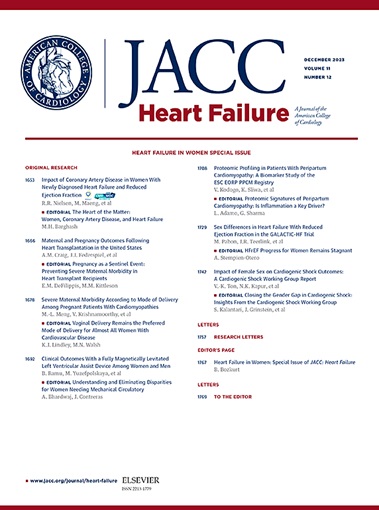Nonsteroidal and Steroidal Mineralocorticoid Antagonists
IF 11.8
1区 医学
Q1 CARDIAC & CARDIOVASCULAR SYSTEMS
引用次数: 0
Abstract
Steroidal mineralocorticoid receptor antagonists (MRAs), such as spironolactone and eplerenone, have demonstrated substantial benefits in randomized controlled trials for patients with heart failure with reduced ejection fraction. However, their effectiveness in heart failure with mildly reduced ejection fraction and heart failure with preserved ejection fraction remains uncertain, and the implementation of this class has remained low, in part due to its side effects and tolerability profile. Emerging therapies that target the mineralocorticoid receptor and/or the production of aldosterone may offer alternative strategies to treat the aldosterone–mineralocorticoid receptor axis. For instance, the nonsteroidal MRA finerenone has shown efficacy in reducing cardiovascular and renal events in patients with type 2 diabetes mellitus and chronic kidney disease, as well as decreasing the combined endpoint of cardiovascular death and heart failure hospitalizations in heart failure with mildly reduced ejection fraction and heart failure with preserved ejection fraction populations. Large-scale, direct comparative outcome studies are currently lacking that compare steroidal MRAs vs emerging therapies. This review critically assesses the structural and mechanistic distinctions between nonsteroidal and nonsteroidal MRAs as well as mineralocorticoid receptor modulators and aldosterone synthase inhibitors; summarizes available evidence across heart failure, diabetes, and chronic kidney disease populations; and highlights ongoing and forthcoming research aimed at addressing key unanswered questions in this rapidly evolving therapeutic field.
非甾体和甾体矿物皮质激素拮抗剂
甾体矿物皮质激素受体拮抗剂(MRAs),如螺内酯和依普利酮,已经在随机对照试验中证明了对射血分数降低的心力衰竭患者的实质性益处。然而,它们在射血分数轻度降低的心力衰竭和保留射血分数的心力衰竭中的有效性仍然不确定,而且这类药物的实施仍然很低,部分原因是其副作用和耐受性。针对矿物皮质激素受体和/或醛固酮产生的新疗法可能提供治疗醛固酮-矿物皮质激素受体轴的替代策略。例如,非甾体MRA finerenone已显示出减少2型糖尿病和慢性肾病患者心血管和肾脏事件的疗效,以及降低心力衰竭伴射血分数轻度降低和心力衰竭伴射血分数保留人群心血管死亡和心力衰竭住院的综合终点。目前缺乏比较类固醇MRAs与新兴疗法的大规模、直接比较结果的研究。这篇综述批判性地评估了非甾体和非甾体MRAs以及矿物皮质激素受体调节剂和醛固酮合成酶抑制剂之间的结构和机制差异;总结心力衰竭、糖尿病和慢性肾脏疾病人群的现有证据;并强调了正在进行和即将进行的研究,旨在解决这一快速发展的治疗领域中未解决的关键问题。
本文章由计算机程序翻译,如有差异,请以英文原文为准。
求助全文
约1分钟内获得全文
求助全文
来源期刊

JACC. Heart failure
CARDIAC & CARDIOVASCULAR SYSTEMS-
CiteScore
21.20
自引率
2.30%
发文量
164
期刊介绍:
JACC: Heart Failure publishes crucial findings on the pathophysiology, diagnosis, treatment, and care of heart failure patients. The goal is to enhance understanding through timely scientific communication on disease, clinical trials, outcomes, and therapeutic advances. The Journal fosters interdisciplinary connections with neuroscience, pulmonary medicine, nephrology, electrophysiology, and surgery related to heart failure. It also covers articles on pharmacogenetics, biomarkers, and metabolomics.
 求助内容:
求助内容: 应助结果提醒方式:
应助结果提醒方式:


